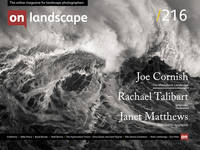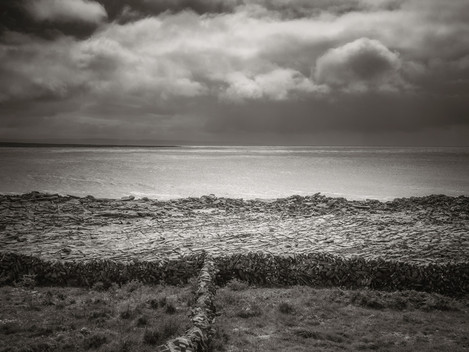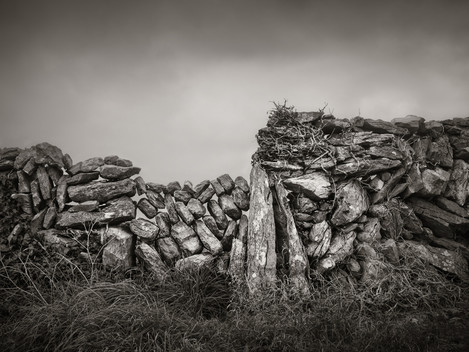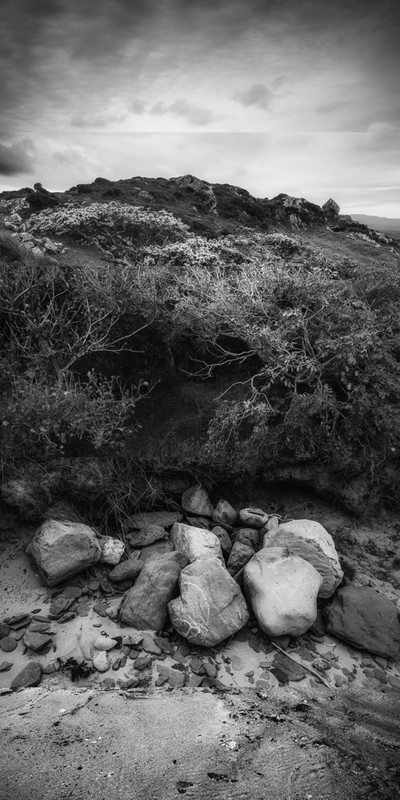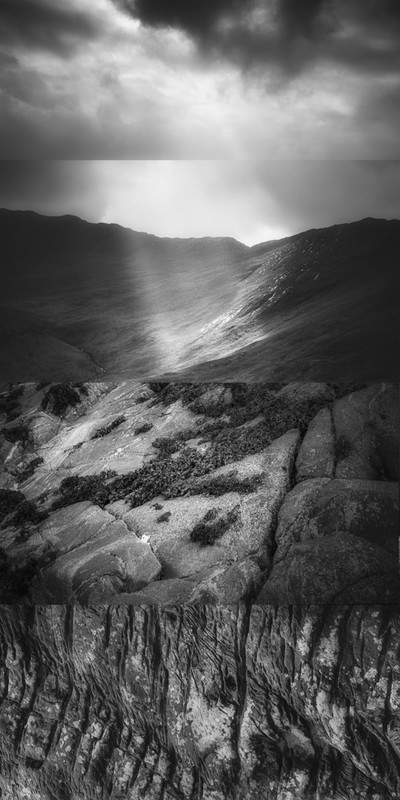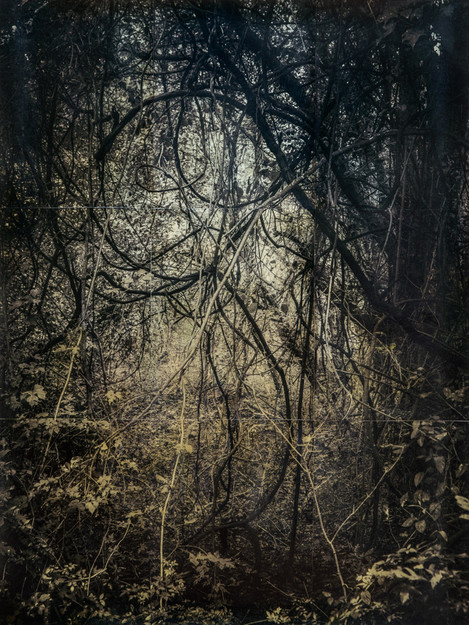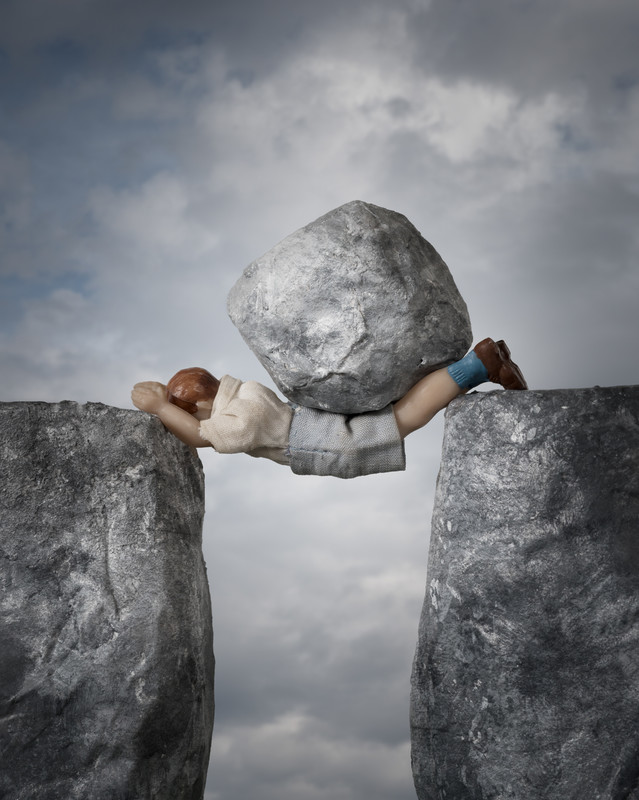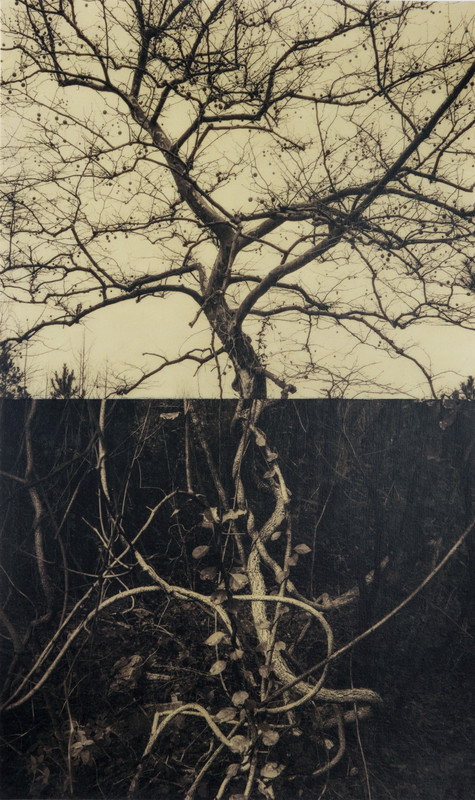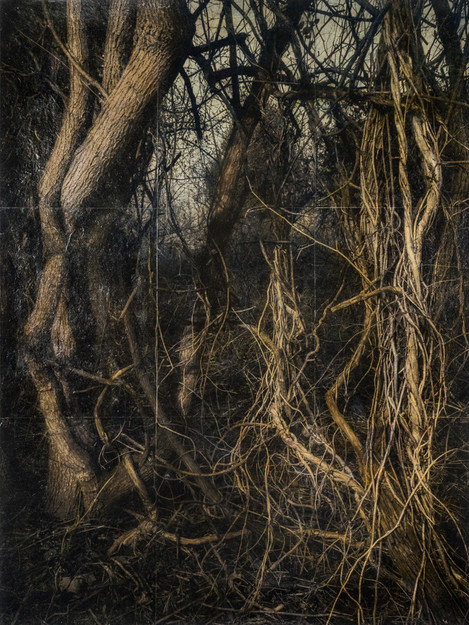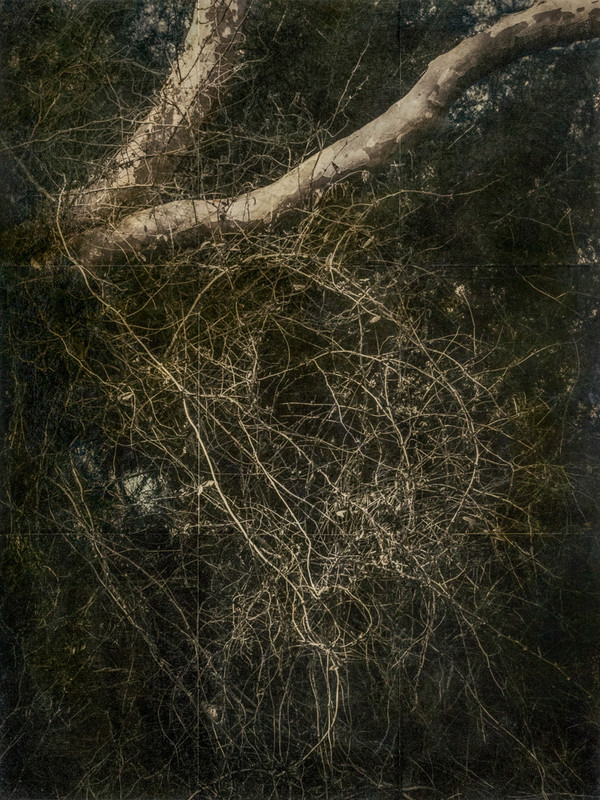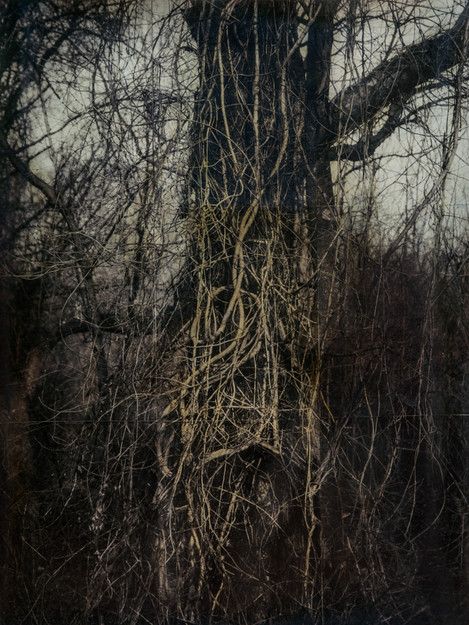Featured Photographer

Janet Matthews
Janet Matthews is a Maryland-based artist who explores psychological themes through evocative still life and landscape images. Her background in drawing and painting has influenced her approach to photography, as she often incorporates hands-on methods into her work.

Michéla Griffith
In 2012 I paused by my local river and everything changed. I’ve moved away from what many expect photographs to be: my images deconstruct the literal and reimagine the subjective, reflecting the curiosity that water has inspired in my practice. Water has been my conduit: it has sharpened my vision, given me permission to experiment and continues to introduce me to new ways of seeing.
It’s fortunate for us that Janet Matthews was tasked to teach photography as part of her duties in art education. In the process of preparing the lessons, she fell in love with the medium. Unsurprisingly, it was the magic of traditional processes that prompted this, and while much of her current output is digital, you can see a legacy of the darkroom in it. She has moved from still life to explore man’s imprint on the landscape and to examine through its detail our own complexities of life and thought. New work interrogates the visual threads within a view and composites these into imaginary landscapes.
Would you like to start by telling readers a little about yourself – where you grew up, your education and early interests, and what that led you to do?
I grew up in suburban towns in Illinois, Michigan and Missouri in the U.S. My family moved to Maryland, near Washington DC, when I was a teenager, and I have lived here ever since.
Imagination and creative play with siblings and friends was an important part of my childhood. The making of things was often involved, and my mother, an avid crafter and DIYer, provided us with both inspiration and an abundance of craft materials to experiment with. I was particularly interested in learning to draw, and acquired many “How-To-Draw” books and drawing supplies as I grew up. I was also an insatiable reader. I have looked back to those times and explored ideas about memory, creativity and childhood in a few of my early series.
I attended the University of Maryland as a studio art major after graduating from high school. I dropped out freshman year but returned 10 years later to complete my B.A. degree, with a focus on painting and drawing.
How did photography come (back) into your life? What transformation did it effect?
After leaving the structured environment of the university program, I found it difficult to work as an artist independently, particularly in light of family responsibilities. My priorities had changed, and I found myself becoming active as a classroom volunteer at my children’s schools as well as developing an interest in education. When my younger son started first grade, I began to think about combining my interests by becoming an art teacher. I soon returned to the University of Maryland and entered an Art Education program.
After earning a degree in Art Education, I was hired to teach at a high school and was assigned a course load that included Photo 1. Although I had taken a few photography classes in college and had very basic darkroom experience, I realised I would need to refresh and extend my skills. I began attending continuing education courses at the Maryland Institute College of Art. That first semester as a teacher, I felt as if I was keeping only a step or two ahead of my students. We started with photograms, then progressed to making and using pinhole cameras and included a lot of photo history along the way. I began to appreciate photography as an image-making process. Later in the semester, we worked with Liquid Light, a hand-applied silver gelatin emulsion. This was an “aha!” moment for me: I found a connection to my own artwork. I began working with Liquid Light and mixed media. Once I became aware of other hand-coated historic photography processes, I started taking workshops to learn more and began developing projects that used these processes. As I continued to learn more about the history and processes of photography, as well as becoming familiar with work by contemporary photographers, I became more motivated and focused on making my own work.
Who (photographers, artists or individuals) or what has most inspired you, or driven you forward in your own development as both an artist and a photographer?
Years ago my mother subscribed to a series of art appreciation books from the Metropolitan Museum. Each month a new book would arrive featuring colour plates of artworks that demonstrated a specific theme: composition, technique, historical styles and so on. I was fascinated by these books. To this day, I still love looking at and am inspired by art and photography by many different artists. That being said, there are a few photographers in particular, whose work I find particularly inspiring. Sally Mann (Read Joe Cornish's book review Hold Still)is fearless in her pursuit and use of concepts and processes and creates exceptionally beautiful images. Robert and Shana ParkeHarrison have created powerful images that incorporate mixed media and performance. Mike and Doug Starn have created conceptual artwork that uses photography in a raw and sculptural way. These photographers have inspired me in the way that they have pushed the boundaries of photography into new areas.
The alternative process photography community has also helped my artistic development. The photographers are supportive of one another and generous in sharing techniques and advice.
Your recent series focuses more on the landscape. I know that a health scares accelerated the shift in subject matter, but did anything prompt the change in the first place?
In the past, I had made attempts at working with the landscape, but I didn’t feel a real connection to the subject, which was reflected in my images. I just felt more comfortable working in a studio (which was a table in the dining room for many years) where I had more control over my subject and environment. Later, I came upon the work of Julian Calverley on Instagram, a project that he called iPhone Only. He was posting lovely, dramatic landscape images that he made with his iPhone while on commercial assignments. I enjoy playing with photo apps so I decided to try to imitate the style of his images as an exercise. I started feeling more comfortable and continued shooting outdoor scenes.
In 2015, a photographer friend and I started planning a month-long trip to Ireland. We wanted to rent a house and invited a few other photographer friends along. I wanted to have some project ideas to work on during this visit. I had been to Ireland previously and knew that the landscape was pretty spectacular and different from the landscape I’m used to seeing at home. The photographers who were going to be sharing the house were all landscape photographers and I thought this would be an opportunity to take myself outside of my comfort zone and learn from them. It was a great learning experience that helped me begin to recognise aspects of the landscape that interested me.
I had been working on a studio-based project prior to the trip, and when I returned home, I resumed working on it and set landscape aside. I exhibited this project early in 2017, but before the opening of the show, I had a heart attack. It was this experience that sent me back to landscape.
What is it about the landscape that now draws you to it?
I started visiting woodlands with my camera at a time when I needed a place to reflect on life. This was at the time when the leaves had already fallen, making visible the underlying structures created by the branches and vines. There seemed to be a sense of controlled chaos in nature that I found very appealing. I was much more observant than I had been in the past. I enjoyed finding interesting forms, which suggested sanctuaries and portals. The anthropomorphic qualities of the trees were on display. The space felt welcoming and intimate and contemplative. I realised that I could go beyond simply representing nature/landscape if I left myself open to it. It was another one of those “aha!” moments.
Where do you most enjoy exploring? You’re clearly drawn to Ireland but presumably, you have developed a connection with places closer to home too?
The Tangled series was photographed at some local wooded parks and wetlands that I have visited and revisited a number of times. There are a variety of natural areas in Maryland, including shorelines, wetlands and forests, which are within an hour or two of home that I am looking forward to exploring in the autumn when the weather is cooler.
While the camera is only a tool, which ones are you currently enjoying playing with? How much of your workflow is digital, and how much analogue?
I mainly use a DSLR (Nikon D610) to make photographs. The cameras that I enjoy playing with are my iPhone and several plastic Holga cameras that I often take with me, plus a couple of cameras in the Lomo/toy camera category. I like to use my iPhone for documenting and for sketching or trying out visual ideas. The Holga is a pretty low-tech film camera. The plastic lens is prone to distortion and vignetting, while there are virtually no controls for exposure or focus. Because there is less control over the outcome, the Holga frees me to photograph in a less analytical, more intuitive manner. And I won’t be able to see what I’ve got until the film is processed. It’s a great tool for loosening up as well as learning how to see.
For my past several projects I have worked with digital processes from start to finish. However, there are a couple of analogue printing processes that I am interested in eventually using if I have an appropriate project for them. In terms of workflow, I currently use a digital camera for image capture, Adobe Lightroom and Photoshop for post-processing, and an Epson pigment printer for making prints. However, I sometimes use film (as with a Holga or toy camera), which I scan and then process and print digitally. If I am planning to use an analogue process to make the print, I will use the digitally processed image to print a digital negative on transparency film to use for contact printing.
Would you like to choose 2-3 favourite photographs from your own portfolio and tell us a little about why they are special to you?
It is difficult to choose favourite single images from past work because I usually consider my newest images to be my favourites. Instead, I have chosen some images that represent ways in which new ideas have presented themselves to me.
Caught in the Middle from the Small Anxieties series
This series is the first (and thus far, only) body of work that I produced in colour. I initially processed these as monochrome images until I realised that colour was an integral part of this work. Small Anxieties was a further development of a previous series, Vignettes, which addressed similar themes of children’s play. Vignettes, however, was printed in monochrome which suited that work better.
Contemplation 1 from the Tangled series
I shot hundreds of images while working on Tangled. I was interested in continuing to engage with some images that had not made the final cut so I experimented with possibilities. This is one from a group of diptychs that I created using cropped portions from the original photos. These diptychs suggested some new ideas regarding part vs. whole that I have explored in some newer work.
Can you give readers an insight into the processes that you’ve used to process and print the images that they see here?
I generally work in monochrome as I see the image in terms of forms and tonalities, lights and darks. I feel that I make stronger images when not distracted by colour. I occasionally add subtle colour to a monochrome image with hand colouring if I feel that it adds to the image. My Small Anxieties project is the one exception to my monochrome approach.
All of the work shown here was captured using a DSLR and post-processed using Adobe Lightroom and Photoshop. My approach to post-processing involves primarily image cleanup and contrast adjustment. I usually start in Lightroom where I remove sensor dust spots, reduce noise when necessary, and adjust clipping points. I follow that with some global contrast adjustments making sure that I leave enough flexibility to fine tune in Photoshop. When I move the image to Photoshop, I convert the image to black and white and then adjust local contrast using Curves Adjustment Layers with masks. I sometimes soften the image a bit using the Nik Color Efex plugin. Finally, I make the print using an Epson pigment inkjet printer. I usually print on Canson Rives BFK or Edition Etching, both of which have a relatively soft surface.
Small Anxieties: I composited my image of the sky into the background and did not include a black and white conversion.
Tangled: The Tangled series is based on the process of healing. The images were assembled from multiple pieces into a coherent whole to suggest that process. I began to experiment with printing on several Japanese papers. This project was printed on lightweight, unbleached (yellowish tonality) kozo paper as monochrome images. The images were printed in nine separate pieces (or two pieces for the diptychs) that were reassembled and adhered to a sheet of 22x30” Rives BFK paper. I used thinned acrylic paint to add subtle colour to the images and finished with a polymer varnish topcoat. The diptych images did not receive the addition of colour.
Recent Work - Constructed Landscapes: This series is currently in progress. The name Constructed Landscapes serves as a placeholder until I decide on the final title. This work began as a continuation of the diptychs done in Tangled, but using my existing Ireland landscape images.
What have you been able to bring to making and printing images from your background in drawing and painting?
Having knowledge of working with various art media opens up many possibilities for approaching the printing of my work, and to add another layer of meaning to the image. Process has always been an important part of my image making practice. By that I mean that my creative process involves a certain amount of dialogue with the image as it is coming into being. The act of post processing digitally involves a sort of back and forth that feels very much like drawing to me. I don’t consider myself a pre-visualiser. I think of the image capture as only the beginning of the making of the image, similar to making the first mark on a blank sheet of paper or canvas. I also like the tangible quality of a handmade print, its presence as an object. It involves leaving a trace of the hand of the artist in the artwork. This is the reason I often include a hands-on component to the making of print.
Do you have any particular projects or ambitions for the future or themes that you would like to explore further? I noticed that you did a papermaking course in May.
I consulted with an artist who makes paper as to whether the paper-making process could support this idea. She offered some advice and invited me to participate in an upcoming online paper-making workshop. I learned some basics about materials and techniques. I plan to continue experimenting with papermaking methods.
If you had to take a break from all things photographic for a week, what would you end up doing? What other hobbies or interests do you have?
I have always had craft projects going on in the background. I’ve gone through many periods of high interest in one type of craft or another: a needlework phase, basket-making phase, beading phase, and so on. Recently I have revived an interest in making dollhouse miniatures. I had started working on a dollhouse in the 1990s, but never brought it to completion. It had been sitting in the basement collecting dust until I retrieved it last winter and began to work on it again.
I am also very interested in making books by hand. Although I sometimes use my photography as content, I am primarily interested in the book as an object. I’m somewhat of a novice in terms of skills, but I enjoy learning how to make the various book structures.
And finally, is there someone whose photography you enjoy – perhaps someone that we may not have come across - and whose work you think we should feature in a future issue? They can be amateur or professional.
I have recently come across two photographers online, who create wonderful images. Saskia Boelsums is a Dutch photographer who creates very painterly landscape images that reference 17th century Dutch landscape painting. Her work has a beautiful sense of light. Nobuyuki Kobayashi is a Japanese photographer who does sensitive, large format landscapes that he prints with platinum/palladium.
Thank you, Janet, for a fascinating insight. We’re very much looking forward to seeing how your ideas develop.
You can see more of Janet’s images on her website and you’ll also find her on Instagram.

